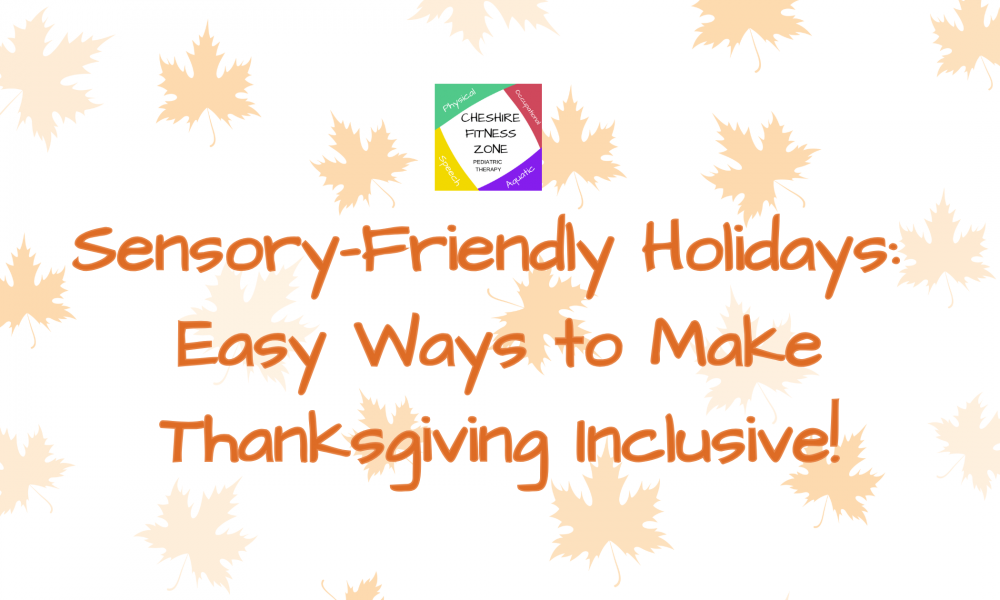Sensory-Friendly Holidays: Easy Ways to Make Thanksgiving Inclusive!
Thanksgiving is just around the corner, and soon families and friends will come together to celebrate. While the holiday season is a time for fun, games, and catching up, it can also be overwhelming for some. This year, let’s focus on making sensory-friendly adjustments so everyone can enjoy the festivities!
What Does It Mean to Make Something Sensory-Friendly?
A sensory-friendly environment is one that accommodates individuals with sensory needs. To create a sensory-friendly space, it’s important to minimize factors that might cause overwhelming sensory input. When considering if a space is sensory-friendly, think about lighting, sound, colors, smells, and textures. This could mean dimming the lights, reducing noise, setting up quiet areas, and offering sensory items like fidgets for stimulation.
How to Make Your Holiday Sensory-Friendly:
Create Calm and Quiet Spaces
It can be helpful to have a calming area where guests, especially children, can retreat for a sensory break. Whether you’re at home or visiting a relative’s house, designate a quiet space in advance and show your child where it is. Let them know that this area is available if they need to calm down or take a break.
Prepare Calming Activities
Prepare simple, portable sensory activities ahead of time.
Occupational therapist Lizzy Darin shares her advice:
“Kids with autism or sensory processing challenges often benefit from familiarity and routine. Ensuring they have access to their favorite calming items can help prevent a sensory meltdown. Consider packing a sensory kit with your child’s preferred strategies and items, such as noise-canceling headphones, textured toys, or soothing visual stimuli.”
Sensory-Friendly Foods and Meal Prep
Different foods can be another area of concern for kids during the holidays. The smell, texture, and visual appearance of certain foods may be overwhelming for individuals with sensory sensitivities. To create a more sensory-friendly Thanksgiving meal, consider the following:
Offer a Variety: Serve a mix of foods with different textures and flavors. Options that are neutral or familiar, such as mashed potatoes, plain rolls, or simple fruits, can help reduce stress around mealtime.
Be Mindful of Smells: Strong cooking odors such as turkey, pies, or spices, can be overwhelming. If you’re hosting at home, try ventilating the area to diminish strong smells or consider preparing foods in advance to minimize smells during the holiday.
Preparing for Sensory Sensitivities During Games and Activities
While family games and group activities can be a fun way to bond, they may also become overwhelming for some. Here are a few strategies to make games and activities more sensory-friendly:
Provide Options for Quiet Play: Not every guest will want to participate in loud or competitive games. Offer quieter alternatives like puzzles, drawing materials, or books, giving children a break from more stimulating group activities.
Plan Breaks Between Games: If your family enjoys activities like charades, board games, or trivia, schedule breaks in between rounds. This gives anyone who needs a sensory break the chance to step away or reset. It’s also important to offer alternatives to ensure everyone feels comfortable participating at their own pace.
Communication and Flexibility
Clear communication is crucial when making your Thanksgiving sensory-friendly. This is especially important if you’re hosting someone with sensory needs for the first time. Be open about the sensory accommodations you’re making, and ask your guests if they have specific preferences or needs.
Occupational Therapist Lizzy Darin’s advice:
“It may be helpful to have a calming area for a child to go to take a sensory break both at home or at unfamiliar places such as a relatives house. Show the child this area ahead of time and let them know that this space can be used if they need to calm down or take a break.”
Managing Noise and Lighting
Holiday gatherings often come with increased noise levels and bright lights, which can be overwhelming for people with sensory sensitivities. Here are a few tips to adjust the environment:
Dim the Lights: Bright or flashing lights can be a trigger for some. Dim the lights or use softer bulbs, and consider setting up a cozy, low-light space to help reduce visual stimulation.
Reduce Background Noise: For individuals sensitive to loud sounds, noise-canceling headphones or earplugs can be helpful. If the volume of music or conversations is getting too loud, don’t hesitate to turn it down or create a designated quiet area where people can relax.
Happy Thanksgiving!
By making these simple sensory-friendly adjustments, you can create an environment where everyone feels comfortable and included. This will help ensure your holiday gatherings are enjoyable for all.
Happy Thanksgiving!



